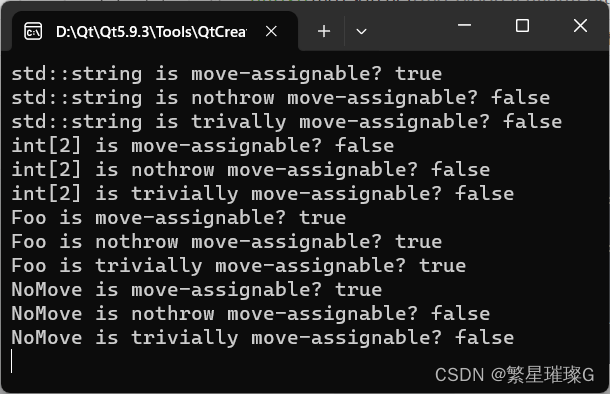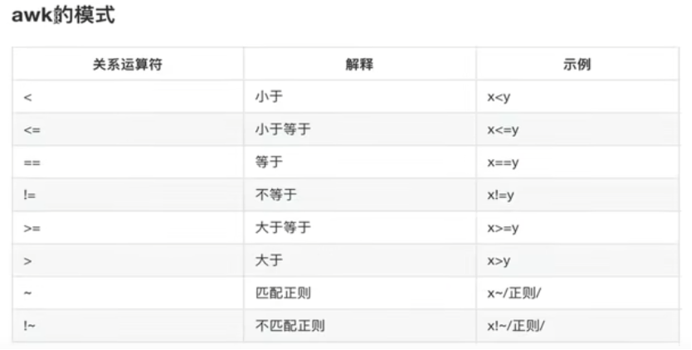路由协议
Eigrp

EIGRP:Enhanced Interior Gateway Routing Protocol 即 增强内部网关路由协议。也翻译为 加强型内部网关路由协议。 EIGRP是Cisco公司的私有协议(2013年已经公有化)。 EIGRP结合了链路状态和距离矢量型路由选择协议的Cisco专用协议,采用弥散修正算法(DUAL)来实现快速收敛,可以不发送定期的路由更新信息以减少带宽的占用,支持Appletalk、IP、Novell和NetWare等多种网络层协议。该协议是一个内部网关协议。不同协议类型如下:
- IGP:内部网关协议,在一个自治系统内运行。比如:RIP、OSPF、IS-IS、EIGRP等。
- EGP:外部网关协议,用于连接不同的自治系统。比如:BGP
EIGRP报文
#字段解释
Cisco EIGRP
Version: 2 #协议号
Opcode: Hello (5) #Opcode字段,报文类型:1 Update、 3 Query、 4 Reply、 5 Hello/ACK
Checksum: 0xeecb [correct]
[Checksum Status: Good]
# 标志(0x01表示INIT,0x02表示CR) INIT标志表示发送给新邻居的第一个初始化Update报文,这个报文将携带所有的路由信息,而以后的普通的Update报文将只携带变化了的路由信息
Flags: 0x00000000
.... .... .... .... .... .... .... ...0 = Init: Not set
.... .... .... .... .... .... .... ..0. = Conditional Receive: Not set
"""
CR状态的作用:
某路由器R在一个接口上有A,B,C三个邻居.它向这个接口发送了一个Update报文,然后收到了A,C的确认,但是因为某种原因没有收到B的确认,这样无法知道B是否收到了这份Update报文.此时,路由器R既不想继续等B的确认;也不希望B在没有收到第一份Update报文的情况下接收第二份Update报文,因为这种失序有可能引起混乱.
于是,路由器R发了一个带有Sequense TLV的Hello报文,里面列出了B的IP地址,这样A,C就会将自己置于CR状态,B则会保持正常态.R发出的后续Update报文将在报文头中打上CR标志,这样只有A,C才会接收到这些报文,而B因为不是CR状态,将会忽略带有CR标志的报文,这样就保证了B不会接收到失序的报文.路由器R将在稍后向B依次发送B所错过的报文
"""
.... .... .... .... .... .... .... .0.. = Restart: Not set
.... .... .... .... .... .... .... 0... = End Of Table: Not set #分享路由信息
Sequence: 0 #报文的序列号,用于确认机制,不需要确认的报文,如Hello报文,这个域为0.
Acknowledge: 0 #文携带的确认信息.表示已经收到了此序列号的报文.
Virtual Router ID: 0 (Address-Family)
Autonomous System: 1 #自治系统号一般来说就是进程号.
Parameters
Type: Parameters (0x0001)
Length: 12
K1: 1
K2: 0
K3: 1
K4: 0
K5: 0
K6: 0
Hold Time: 15
Software Version: EIGRP=12.4, TLV=1.2
Type: Software Version (0x0004)
Length: 8
EIGRP Release: 12.04
EIGRP TLV version: 1.02
# Sequense TLV可能出现在Hello报文中,它的TLV Type为0x0003,它的作用让某些邻居路由器进入到CR(Conditional Receive)状态.表示了一个邻居路由器的IP地址,Sequense TLV可以携带多个IP地址的列表.凡是接收到这个TLV的邻居路由器将检查自己是否在这个列表中,如果不在这个列表中,则把自己置为CR状态.只有处于CR状态的路由器,才能接收带有CR标志的报文.(EIGRP报文头部分中关于Flags字段的说明).
Sequence
Type: Sequence (0x0003)
Length: 9
Address length: 4
IP Address: 10.0.0.1
"""
Next Multicast Seq TLV可以出现在Hello报文中,它的TLV Type为0x0005.它需要和与Sequense TLV配合使用,单独的Next Multicast Seq TLV没有意义.
在有Sequense TLV,但没有Next Multicast Seq TLV时,表示处于CR状态的邻居路由器可以接收以后所有带CR标志的报文.在有Sequense TLV和Next Multicast Seq TLV都有时,则Next Multicast Seq TLV指定了一个序列号,处于CR状态的邻居路由器只可以接收带CR标志,并且序列号为这个指定序列号的报文.
"""
Next multicast sequence: 25
Type: Next multicast sequence (0x0005)
Length: 8
Multicast Sequence: 25 #Seq Number:下一个可以接收的多播报文的序列号.
# update消息
Opcode: Update (1)
Checksum: 0x24b9 [correct]
[Checksum Status: Good]
Flags: 0x00000008, End Of Table
.... .... .... .... .... .... .... ...0 = Init: Not set
.... .... .... .... .... .... .... ..0. = Conditional Receive: Not set
.... .... .... .... .... .... .... .0.. = Restart: Not set
.... .... .... .... .... .... .... 1... = End Of Table: Set #标志位
Sequence: 24
Acknowledge: 23
Virtual Router ID: 0 (Address-Family) #入这条路由的路由器的IP地址
Autonomous System: 100 #引入这条路由的路由器所在的自治系统.
Internal Route(IPv4) = 192.168.1.0/24
Type: Internal Route(IPv4) (0x0102) # 0x0103表示扩展路由
Length: 28
NextHop: 0.0.0.0 #路由的下一跳的IP地址.
#Delay,Bandwidth,MTU,Hop Count,Reliability,Load:依次是总延时,最小带宽,MTU值,跳数,可信度,负载.
Legacy Metric
Scaled Delay: 2560 #延迟
Scaled BW: 25600 #带宽
MTU: 1500 #MTU
Hop Count: 0 #路由器跳数
Reliability: 255
Load: 1
Route Tag: 0
Flags
.... ...0 = Source Withdraw: False
.... ..0. = Candidate Default: False
.... .0.. = Route is Active: False
.... 0... = Route is Replicated: False
Prefix Length: 24
Destination: 192.168.1.0
1.Hello:用于邻居发现、建立、保活。目标地址为224.0.0.10,Hello包在邻居收到后不需要确认。
-
用于邻居的发现和维护 5s一次
-
默认使用组播(224.0.0.10)发送(目标地址 ERIP的组播地址)
-
发现、建立、维护邻居关系
-
发送的时候使用接口主IP地址作为源,不会使用辅IP地址
-
K值全部255时也叫goodbye消息
-
网络收敛后,只有hello包发送
2.Update:更新包,携带路由条目信息—目标网络号+度量值。通过组播发送Update数据包,邻居收到后必须回复确认消息。
-
传递路由更新,仅包含需要的路由条目
-
收到第一个Hello包,以单播传送全部路由;路由信息变化,以组播方式发送变化的路由信息
-
当为指定(neighbor)的一台路由器发更新时使用Unicast(P-TO-P) ,当为多台路由器发更新时使用Multicast.(MA)----可靠包
3.Query:查询包,当路由信息丢失并没有备用路由时,使用Query数据包向邻居查询,邻居必须回复确认。
-
当找不到Feasible Successor时,发送查询报文(Multicast)----可靠包
-
若A发现路由变化,先发Update,再发Query
4.Reply:应答包,是对邻居Query数据包的回复,也需要邻居回复确认。
- 回应查询报文,单播。(Unicast)----可靠包//B收到Query后,会先发ACK,Reply
5.ACK:确认包,是对收到的数据包的确认,告诉邻居自己已经收到数据包了,收到Ack后,不需要再对Ack做回复,因为这是没有意义的,并且可能造成死循环
- 用来确认Update/Query/Reply (Unicast),单播报文
6.SIA-QUERY:
- 用于避免SIA超时导致邻居关系重置
7.SIA-REPLY:
- 用于避免SIA超时导致邻居关系重置
使用单播传送的包:reply,ack,使用组播传送的包:Hello,Update和query (224.0.0.10),可靠包:Update,Query,Reply。
##hello消息的结构
Opcode字段,报文类型:1 Update、 3 Query、 4 Reply、 5 Hello/ACK
Sequence字段: the 32-bit sequence number used by the RTP
ACK字段:如果此字段不为零的话,那么这个包就是ACK包而不是Hello包
TLV:Type / Length / Value
TLV Types分为4个大类,如下:
''' TLV消息结构
Parameters
Type: Parameters (0x0001)
Length: 12
K1: 1
K2: 0
K3: 1
K4: 0
K5: 0
K6: 0
Hold Time: 15 默认3倍
'''
1.General TLV Types
0x0001 EIGRP Parameters EIGRP参数
0x0003 Sequence 序列
0x0004 Software Version 软件版本
0x0005 Next Multicast Sequence 下一个组播序列
2.IP-Specific TLV Types
0x0102 IP Internal Routes IP内部路由
0x0103 IP External Routes IP外部路由
3.AppleTalk-Specific TLV Types
0x0202 AppleTalk Internal Routes AppleTalk内部路由
0X0203 AppleTalk External Routes AppleTalk外部路由
0x0204 AppleTalk Cable Configuration AppleTalk电缆配置
4.IPX-Specific TLV Types
0x0302 IPX Internal Routes IPX内部路由
0x0303 IPX External Routes IPX外部路由
hello消息 抓包报文
#普通hello消息
Cisco EIGRP
Version: 2
Opcode: Hello (5)
Checksum: 0xeecb [correct]
[Checksum Status: Good]
Flags: 0x00000000
Sequence: 0
Acknowledge: 0 #有值时为 ack消息
Virtual Router ID: 0 (Address-Family)
Autonomous System: 1
Parameters
Type: Parameters (0x0001)
Length: 12
K1: 1
K2: 0
K3: 1
K4: 0
K5: 0
K6: 0
Hold Time: 15
Software Version: EIGRP=12.4, TLV=1.2
Type: Software Version (0x0004)
Length: 8
EIGRP Release: 12.04
EIGRP TLV version: 1.02
#携带下一个组播序号的hello
Cisco EIGRP
Version: 2
Opcode: Hello (5)
Checksum: 0xc352 [correct]
[Checksum Status: Good]
Flags: 0x00000000
.... .... .... .... .... .... .... ...0 = Init: Not set
.... .... .... .... .... .... .... ..0. = Conditional Receive: Not set
.... .... .... .... .... .... .... .0.. = Restart: Not set
.... .... .... .... .... .... .... 0... = End Of Table: Not set
Sequence: 0
Acknowledge: 0
Virtual Router ID: 0 (Address-Family)
Autonomous System: 100
Parameters
Type: Parameters (0x0001)
Length: 12
K1: 1
K2: 0
K3: 1
K4: 0
K5: 0
K6: 0
Hold Time: 15
Software Version: EIGRP=12.4, TLV=1.2
Type: Software Version (0x0004)
Length: 8
EIGRP Release: 12.04
EIGRP TLV version: 1.02
Sequence
Type: Sequence (0x0003)
Length: 9
Address length: 4
IP Address: 10.0.0.1
Next multicast sequence: 25
Type: Next multicast sequence (0x0005)
Length: 8
Multicast Sequence: 25
update消息 抓包报文
#会话建立 1 from 1 to 2
Cisco EIGRP
Version: 2
Opcode: Update (1)
Checksum: 0xfd82 [correct]
[Checksum Status: Good]
Flags: 0x00000001, Init
.... .... .... .... .... .... .... ...1 = Init: Set
.... .... .... .... .... .... .... ..0. = Conditional Receive: Not set
.... .... .... .... .... .... .... .0.. = Restart: Not set
.... .... .... .... .... .... .... 0... = End Of Table: Not set
Sequence: 23
Acknowledge: 0
Virtual Router ID: 0 (Address-Family)
Autonomous System: 100
#会话建立 2 from 2 to 1
Cisco EIGRP
Version: 2
Opcode: Update (1)
Checksum: 0xfd6b [correct]
[Checksum Status: Good]
Flags: 0x00000001, Init
.... .... .... .... .... .... .... ...1 = Init: Set
.... .... .... .... .... .... .... ..0. = Conditional Receive: Not set
.... .... .... .... .... .... .... .0.. = Restart: Not set
.... .... .... .... .... .... .... 0... = End Of Table: Not set
Sequence: 23
Acknowledge: 23
Virtual Router ID: 0 (Address-Family)
Autonomous System: 100
#路由信息传递1 from 1 to 2
Cisco EIGRP
Version: 2
Opcode: Update (1)
Checksum: 0x24b9 [correct]
[Checksum Status: Good]
Flags: 0x00000008, End Of Table
.... .... .... .... .... .... .... ...0 = Init: Not set
.... .... .... .... .... .... .... ..0. = Conditional Receive: Not set
.... .... .... .... .... .... .... .0.. = Restart: Not set
.... .... .... .... .... .... .... 1... = End Of Table: Set
Sequence: 24
Acknowledge: 23
Virtual Router ID: 0 (Address-Family)
Autonomous System: 100
Internal Route(IPv4) = 192.168.1.0/24
Type: Internal Route(IPv4) (0x0102)
Length: 28
NextHop: 0.0.0.0
Legacy Metric
Scaled Delay: 2560
Scaled BW: 25600
MTU: 1500
Hop Count: 0
Reliability: 255
Load: 1
Route Tag: 0
Flags
.... ...0 = Source Withdraw: False
.... ..0. = Candidate Default: False
.... .0.. = Route is Active: False
.... 0... = Route is Replicated: False
Prefix Length: 24
Destination: 192.168.1.0
#路由信息传递2 from 2 to 1
Cisco EIGRP
Version: 2
Opcode: Update (1)
Checksum: 0x7d9b [correct]
[Checksum Status: Good]
Flags: 0x00000008, End Of Table
.... .... .... .... .... .... .... ...0 = Init: Not set
.... .... .... .... .... .... .... ..0. = Conditional Receive: Not set
.... .... .... .... .... .... .... .0.. = Restart: Not set
.... .... .... .... .... .... .... 1... = End Of Table: Set
Sequence: 24
Acknowledge: 24
Virtual Router ID: 0 (Address-Family)
Autonomous System: 100
#更新后的路由信息传递 to 组播
Cisco EIGRP
Version: 2
Opcode: Update (1)
Checksum: 0xa2d8 [correct]
[Checksum Status: Good]
Flags: 0x00000002, Conditional Receive
.... .... .... .... .... .... .... ...0 = Init: Not set
.... .... .... .... .... .... .... ..1. = Conditional Receive: Set
.... .... .... .... .... .... .... .0.. = Restart: Not set
.... .... .... .... .... .... .... 0... = End Of Table: Not set
Sequence: 25
Acknowledge: 0
Virtual Router ID: 0 (Address-Family)
Autonomous System: 100
Internal Route(IPv4) = 192.168.1.0/24
Type: Internal Route(IPv4) (0x0102)
Length: 28
NextHop: 0.0.0.0
Legacy Metric
Scaled Delay: 4294967295
Scaled BW: 256000
MTU: 1500
Hop Count: 1
Reliability: 255
Load: 1
Route Tag: 0
Flags
.... ...0 = Source Withdraw: False
.... ..0. = Candidate Default: False
.... .0.. = Route is Active: False
.... 0... = Route is Replicated: False
Prefix Length: 24
Destination: 192.168.1.0
#更新后的路由信息 from 2 to 1
Cisco EIGRP
Version: 2
Opcode: Update (1)
Checksum: 0xa2c2 [correct]
[Checksum Status: Good]
Flags: 0x00000000
.... .... .... .... .... .... .... ...0 = Init: Not set
.... .... .... .... .... .... .... ..0. = Conditional Receive: Not set
.... .... .... .... .... .... .... .0.. = Restart: Not set
.... .... .... .... .... .... .... 0... = End Of Table: Not set
Sequence: 25
Acknowledge: 24
Virtual Router ID: 0 (Address-Family)
Autonomous System: 100
Internal Route(IPv4) = #上一条一致
Query消息
Cisco EIGRP
Version: 2
Opcode: Query (3)
Checksum: 0xf9cc [correct]
[Checksum Status: Good]
Flags: 0x00000000
.... .... .... .... .... .... .... ...0 = Init: Not set
.... .... .... .... .... .... .... ..0. = Conditional Receive: Not set
.... .... .... .... .... .... .... .0.. = Restart: Not set
.... .... .... .... .... .... .... 0... = End Of Table: Not set
Sequence: 5
Acknowledge: 0
Virtual Router ID: 0 (Address-Family)
Autonomous System: 1
Internal Route(IPv4) = 1.1.1.0/24
Type: Internal Route(IPv4) (0x0102)
Length: 28
NextHop: 0.0.0.0
Legacy Metric
Scaled Delay: 4294967295
Scaled BW: 0
MTU: 1514
Hop Count: 0
Reliability: 0
Load: 0
Route Tag: 0
Flags
.... ...0 = Source Withdraw: False
.... ..0. = Candidate Default: False
.... .1.. = Route is Active: True #查询消息
.... 0... = Route is Replicated: False
Prefix Length: 24
Destination: 1.1.1.0
reply
Cisco EIGRP
Version: 2
Opcode: Reply (4)
Checksum: 0xf9c4 [correct]
[Checksum Status: Good]
Flags: 0x00000000
.... .... .... .... .... .... .... ...0 = Init: Not set
.... .... .... .... .... .... .... ..0. = Conditional Receive: Not set
.... .... .... .... .... .... .... .0.. = Restart: Not set
.... .... .... .... .... .... .... 0... = End Of Table: Not set
Sequence: 11
Acknowledge: 5
Virtual Router ID: 0 (Address-Family)
Autonomous System: 1
Internal Route(IPv4) = 1.1.1.0/24
-
大概流程:发送hello消息后,建好邻居表,使用update LSA/LSP LSDB链路状态数据库(可以形成拓扑表)
-
网络结构:Layer 2 |IPV4|EIGRP|FCS protocol| 88 该消息是 先有控制层面,再有数据层面数据。
-
EIGRP使用混合度量值进行计算路径的好坏,主要包含5个方面
-
带宽:bd
-
延迟:delay
-
负载:load
-
可靠性:reliability
-
最大传输单元:MTU(基本不做计算)
-
-
eigrp进行路劲好坏计算时用的两个参数:AD、FD(表示不同的代价,代价由上面的五个参数结合k值(下文)权重计算)。A路由器要到达C路由,需要经过B路由或者D路由,AD是B到C的代价,FD则是A通过计算A到B的代价加上AD 得到新的A由B到C的代价
FD1,或者A由D到C的代价FD2,并使用min(FD1,FD2)得到最优的路径,次路径为备份路径。
-
建立邻居的必要条件
-
收到hello ack
-
匹配AS:EIGRP两台路由器需要建立令居需要AS号相同。
-
相同的度量值(K值)
-
路径度量值权重 (0-255)
k1 1 带宽 的权重
k2 0 负载 的权重
k3 1 延迟 的权重
k4 0 可靠性 的权重
k5 0 最大传输单元 的权重
-
-
-
其他条件:认证通过。
-
报文交换&建立过程
一旦收到任何符合条件(AS相同,度量值权重K相同)邻居的hello报文,则将发送者设置为邻居,并向对方单播发送update报文,该报文不携带路由信息,其中 flag init位置位。
-
step1:10.0.0.2 向224.0.0.10 进行组播
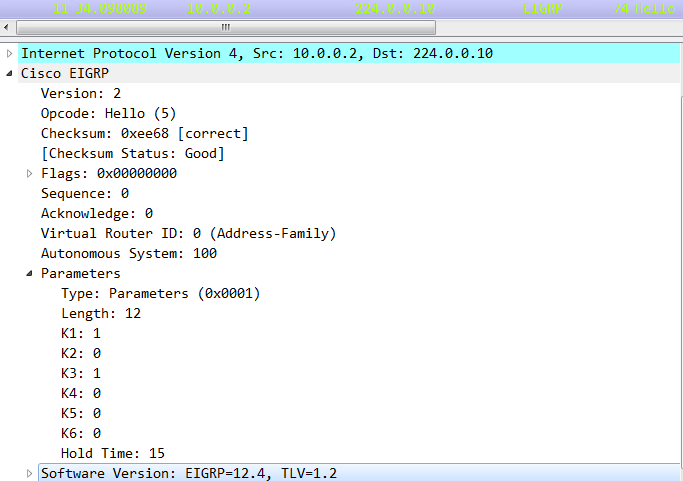
-
step2: 10.0.0.1收到hello消息后,回复给10.0.0.2 单播 update信息,修改init标志位,产生随机序列号。

-
setp4: 10.0.0.2 收到来自10.0.0.1的update消息后,向10.0.0.1发送update消息,并确认序列号,实现握手。

-
step5:10.0.0.1 收到update消息,知道10.0.0.2也是init了,开始向10.0.0.2传播数据。并设置end标志位,表示10.0.0.1的路由信息已传完。

路由参数
# 10.0.0.1 的一条路由信息。
Internal Route(IPv4) = 192.168.1.0/24
Type: Internal Route(IPv4) (0x0102) #内部路由
Length: 28 #
NextHop: 0.0.0.0 #下一跳,0.0.0.0表示自己
Legacy Metric #度量值
Scaled Delay: 25600 #延迟
Scaled BW: 256000 #带宽
MTU: 1500 #MTU
Hop Count: 0 #跳数
Reliability: 255 #可靠性
Load: 1 #负载
Route Tag: 0 #路由标记
Flags
.... ...0 = Source Withdraw: False
.... ..0. = Candidate Default: False
.... .0.. = Route is Active: False
.... 0... = Route is Replicated: False
Prefix Length: 30
Destination: 10.0.0.4 #目的地址
-
step6:10.0.0.2 收到update消息,获取到10.0.0.1的路由信息,同时向10.0.0.1传播本机的路由数据。并设置end标志位,表示10.0.0.2的路由信息已传完。下面的路由是10.0.0.2的。
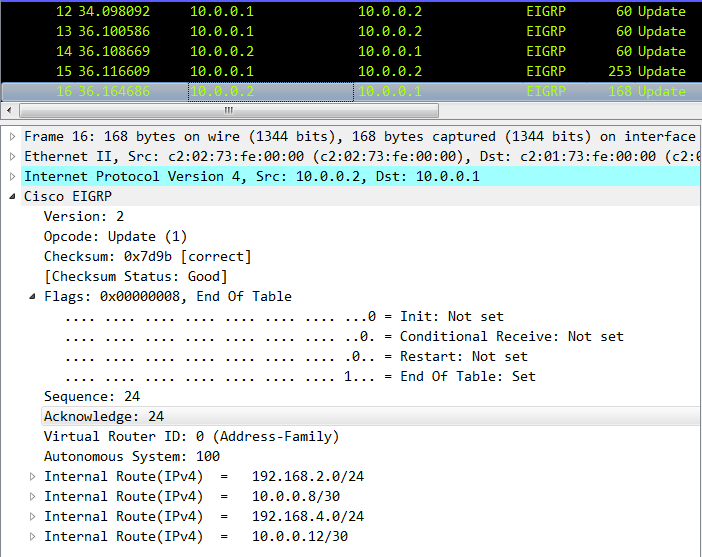
-
step7: 10.0.0.1收到后,向10.0.0.2 发送确认消息 确认号为ack 24。


-
下面为公告自己的最新路由信息
-
step8:在更新完自身的最佳路由后,10.0.0.2 又发hello消息,但是携带的参数更多。包括 序列并 携带下一个组播序列号,接着马上发送更新后的路由信息。该信息中Sequence中的路由器不会被设置为CR,但是其他都会被设置为CR,方便2发送新的CR消息通知其他被设置为CR的路由

-
step9: 10.0.0.2 向组播地址以及 sequence中的路由器 发送update消息 传递参数,携带更新的路由信息(即只发送已更改的、新增或删除的路由信息,而不是发送整个路由表)。发送CR消息,该消息10.0.0.1不会被接受,其他都会被接受

-
step10: 10.0.0.2 向step8中的 sequence中的路由器 发送update消息 告知最近的路由信息。
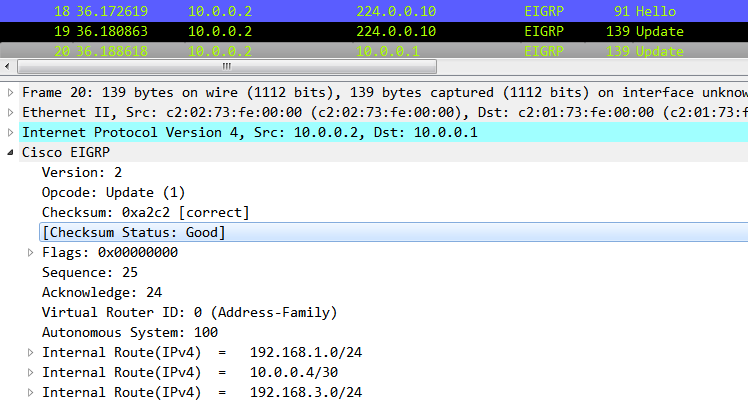
-
step11 : 10.0.0.1 收到update消息后对10.0.0.2进行确认回复。
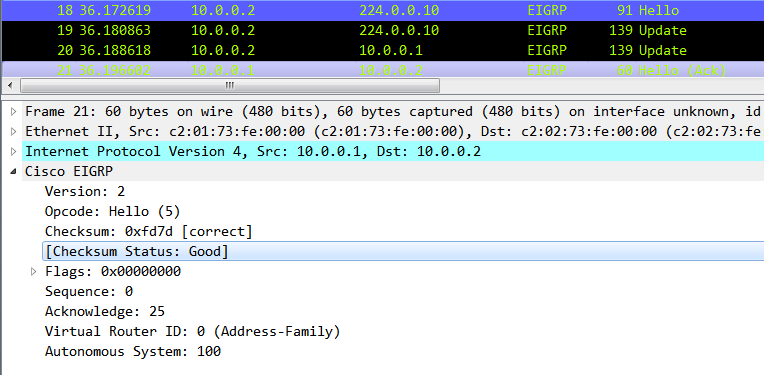
-
step12 : 10.0.0.1 向组播地址 发送update消息 传递参数,携带更新的路由信息(即只发送已更改的、新增或删除的路由信息,而不是发送整个路由表)。

-
step13 : 10.0.0.2 向10.0.0.1 回复确认。

-
更新的路由分析
这里发布的信息是更新的信息,表示路由1 更新了3条路由信息,以跳数为例子(当中涉及其他的权重计算)

-
最终的路由信息,综合更新的路由一起。

-
大致的拓扑结构

两个节点未知
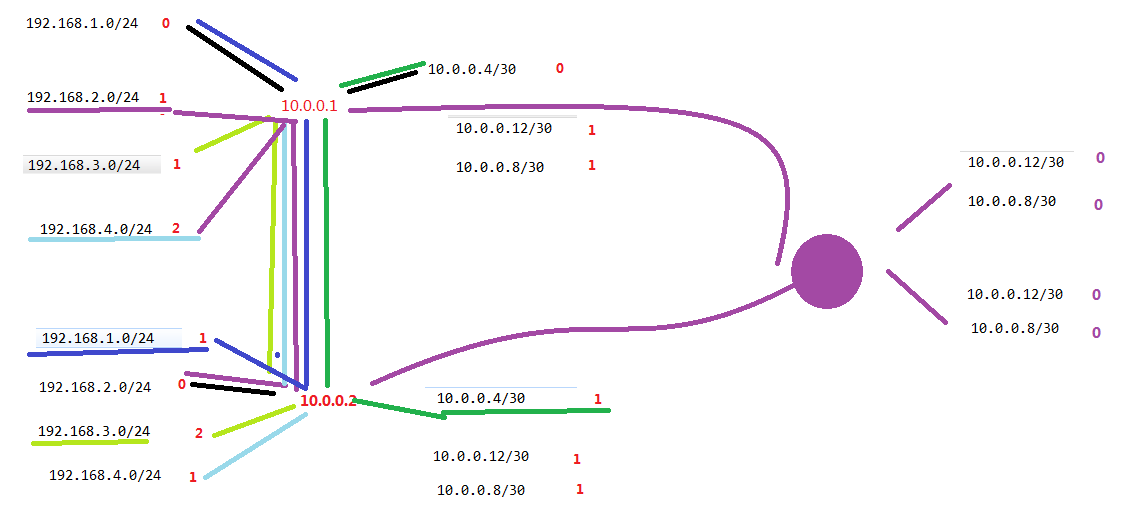
结构突变
(1)新增网段:直连新增网段的设备,使用更新包 update消息告知所有邻居即可
(2)断开网段:直连断开网段的设备,发出查询包Query消息,通过DUAL,收集应答包来重新收敛;完成全网同步。
(3)设备无法沟通:hello time 5s hold time 15s 。hold time (采取的是倒计时方式)计时器结束断开邻居关系,同时产生删除所有从邻居出学习到的信息
断开网段
Cisco EIGRP
Opcode: Query (3)
Internal Route(IPv4) = 1.1.1.0/24
Type: Internal Route(IPv4) (0x0102)
Length: 28
NextHop: 0.0.0.0
Legacy Metric
Scaled Delay: 4294967295
Scaled BW: 0
MTU: 1514
Hop Count: 0
Reliability: 0
Load: 0
Route Tag: 0
Flags
# False,即源撤回标志位未设置。该标志位通常与路由划分和路由更新相关,用于指示是否有源节点撤回了路由信息。
.... ...0 = Source Withdraw: False
#即候选默认路由标志位未设置。候选默认路由用于在没有更具体的路由匹配时,作为默认路径来转发数据包。
.... ..0. = Candidate Default: False
.... .1.. = Route is Active: True #该路由是活动的,被选定为转发数据流量的路径。
.... 0... = Route is Replicated: False#False,即路由未进行复制。这表示该路由未被复制到其他设备上。
Prefix Length: 24
Destination: 1.1.1.0
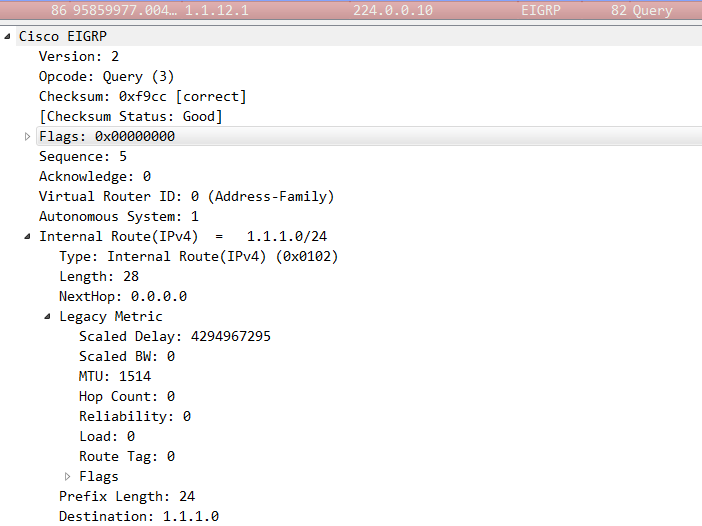
参考文献
参考文献:
https://zhuanlan.zhihu.com/p/393295263
https://blog.csdn.net/Sisyphuss/article/details/132633851
https://www.cisco.com/c/en/us/support/docs/ip/enhanced-interior-gateway-routing-protocol-eigrp/16406-eigrp-toc.html
eigrp关键参数
1 AS号、系数K值是否与自己的一致。如果一致,则建立邻居关系,得到一个自治域的路由器列表。同时监听路由器的hello消息,如果超时,可能该路由已经下线。 编程:将K和AS作为 自治域的 key
Cisco EIGRP
Version: 2
Opcode: Hello (5) #确定消息类型 #Opcode字段,报文类型:1 Update、 3 Query、 4 Reply、 5 Hello/ACK
Checksum: 0xee68 [correct]
[Checksum Status: Good]
Flags: 0x00000000 #确定update消息类型的关键参数 为1 表示 握手,0x00000008表示交换路由信息
Sequence: 0
Acknowledge: 0
Virtual Router ID: 0 (Address-Family)
Autonomous System: 100 #确定自治域的关键参数 *******************
Parameters
Type: Parameters (0x0001)
Length: 12
K1: 1 # #关键参数
K2: 0 # #关键参数
K3: 1 #关键参数
K4: 0 #关键参数
K5: 0 #关键参数
K6: 0 #关键参数
Hold Time: 15
Software Version: EIGRP=12.4, TLV=1.2
Type: Software Version (0x0004)
Length: 8
EIGRP Release: 12.04
EIGRP TLV version: 1.02
2 使用update消息,获取路由信息,根据路由信息 统计路由表
# 1 路由A和B 相互发送该报文 但是IPV4参数不一样 flag为8 携带源ip和目的ip 根据源ip确定该路由的路由变化
Cisco EIGRP
Version: 2
Opcode: Update (1)
Checksum: 0x24b9 [correct]
[Checksum Status: Good]
Flags: 0x00000008, End Of Table #关键参数 确保这是个报文交换消息
Sequence: 24
Acknowledge: 23
Virtual Router ID: 0 (Address-Family)
Autonomous System: 100
Internal Route(IPv4) = 192.168.1.0/24 #关键参数,
Internal Route(IPv4) = 10.0.0.4/30
Internal Route(IPv4) = 192.168.3.0/24
Internal Route(IPv4) = 10.0.0.12/30
Internal Route(IPv4) = 192.168.4.0/24
Internal Route(IPv4) = 10.0.0.8/30
Internal Route(IPv4) = 192.168.2.0/24
#2 AB收到路由信息后,双发 发出更新的路由信息 此时flag为0 携带源ip和目的ip 根据源ip确定该路由的路由变化
Cisco EIGRP
Version: 2
Opcode: Update (1)
Checksum: 0x9dd9 [correct]
[Checksum Status: Good]
Flags: 0x00000000
Sequence: 25
Acknowledge: 0
Virtual Router ID: 0 (Address-Family)
Autonomous System: 100
Internal Route(IPv4) = 192.168.2.0/24
Internal Route(IPv4) = 10.0.0.8/30
Internal Route(IPv4) = 192.168.4.0/24
eigrp拓扑图
-
1 获取自治域。
-
2 获取路由器信息
根据
EIGRP.flag==8判断是否是交换路由消息;根据EIGRP.flag==0判断是否是更新消息。得到两个的报文信息。 -
3 获取路由器的路由表信息
-
4 获取具体的网口信息

处理代码-python
class As_system:
"""自治与"""
def __init__(self, key, as_num, routers):
self.key = key
self.as_num = as_num
self.routers = routers
class Router:
def __init__(self, ASNum, router_id, addr_mac, super_mac, ip):
self.ASNum = ASNum # 路由域
self.router_id = router_id # id
self.addr_mac = addr_mac # 路由器mac
self.super_mac = super_mac # 上级路由器
self.ip = ip
self.port = 0
self.neigbhor = [] # 邻居表
self.router_info_raw = [] # 路由信息
self.router_info_other = [] # 路由信息
self.router_info_new = [] # 路由信息
self.key = hash(addr_mac)
class Internal:
def __init__(self):
self.rouType = 0
self.nextHop = 0
self.metric = 0
self.dst = 0
class Node:
def __init__(self, name):
self.name = name
self.edges = []
def add_edge(self, node, weight=1):
self.edges.append((node, weight))
class Graph:
def __init__(self):
self.nodes = {}
def add_node(self, node):
self.nodes[node.name] = node
def add_edge(self, node1, node2, weight=1):
if node1.name in self.nodes and node2.name in self.nodes:
self.nodes[node1.name].add_edge(node2, weight)
self.nodes[node2.name].add_edge(node1, weight)
else:
raise ValueError("Both nodes must be added to the graph before adding an edge.")
def creat_router(packet):
""""前置条件,hello消息,为组播"""
global router_id
global router_dict
global router_ip_dict
comm = packet["comm"][0]
eigrp = packet["eigrp"]
asnum = eigrp["ASNum"]
# k=eigrp["k"] #获取到key
k = "01001" # 获取到key
as_key = hash((asnum, k))
classic = []
if eigrp["flag"] == 8 and eigrp["opCode"] == 1:
classic = eigrp["classic"]
router_ip_dict[comm["srcMac"]] = classic
if as_key in router_dict:
as_system = router_dict[as_key]
routers = as_system["routers"] #
routers_mac = as_system["routers_mac"] #
if comm["srcMac"] in routers_mac:
router = routers[comm["srcMac"]]
if len(classic) > 0:
router.router_info_raw = classic
else:
router_id += 1
router = Router(asnum, router_id, comm["srcMac"], comm["dstMac"], comm["srcAddr"])
router.router_info_raw = classic
routers[comm["srcMac"]] = router
routers_mac.append(comm["srcMac"])
else:
router_id += 1
router_dict[as_key] = {
"key": as_key,
"as_num": asnum,
"routers": {},
"routers_mac": [comm["srcMac"]]
}
routers = router_dict[as_key]["routers"]
router = Router(asnum, router_id, comm["srcMac"], comm["dstMac"], comm["srcAddr"])
router.router_info_raw = classic
routers[comm["srcMac"]] = router
globals()["router_id"] = 0
globals()["router_dict"] = {}
globals()["router_ip_dict"] = {}
import json
# 指定本地 JSON 文件路径
file_path = "data/0EC0A8582C0C1C4F_192.168.88.44_1.json"
# file_path = "data/data.json"
with open(file_path, "r", encoding="gbk", errors="ignore") as file:
lines = file.readlines()
data_list = []
for line in lines:
data = json.loads(line)
data_list.append(data)
for item in data_list:
creat_router(item) # 创建路由集合
print("end")
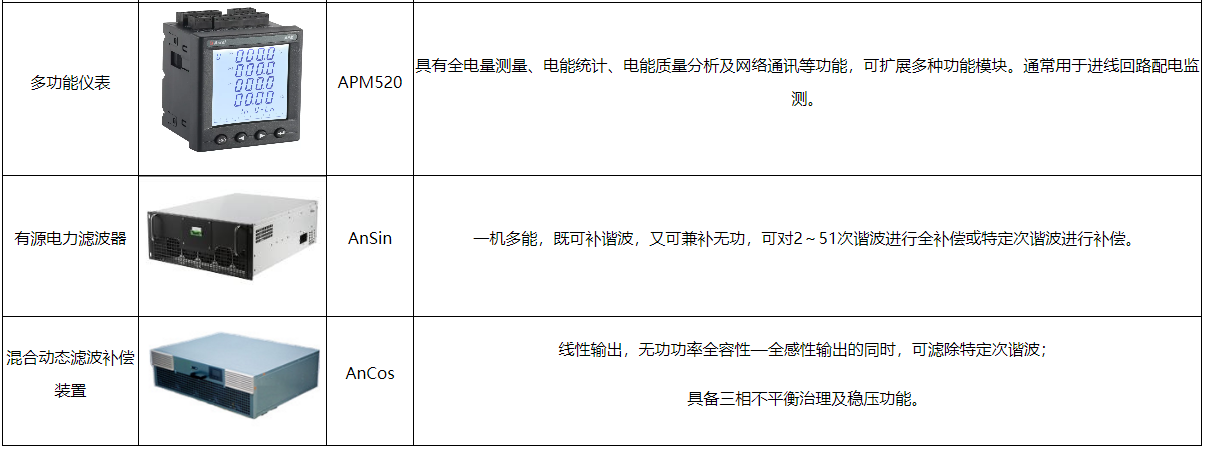







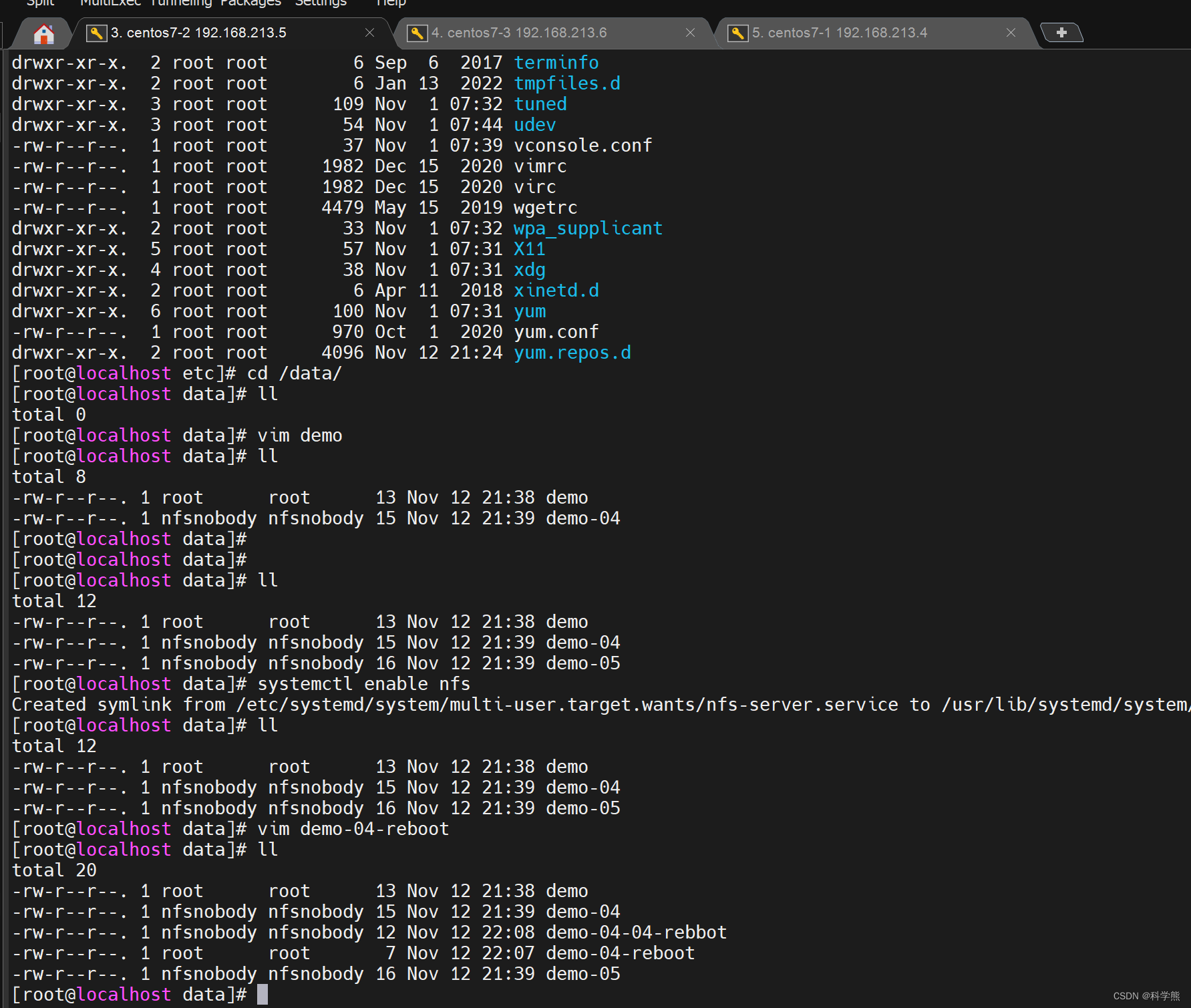

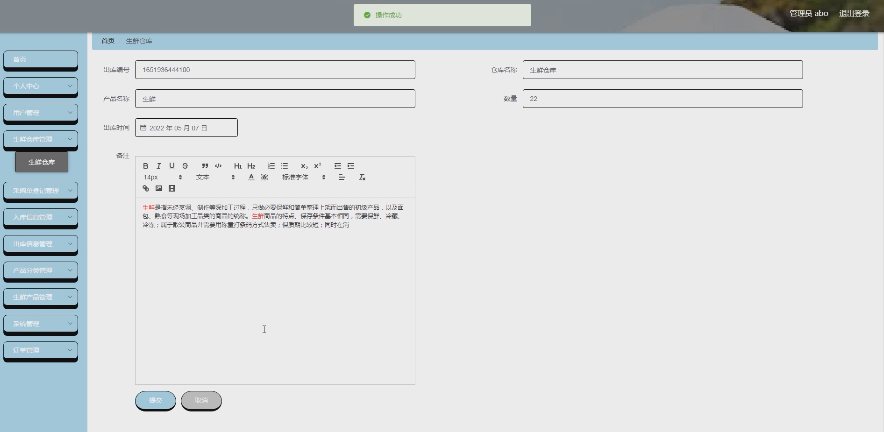




![[SOC] MBIST (Memory Built-In Self Test) and Memory Built-in Self Repair (BISR)](https://img-blog.csdnimg.cn/8b427e9c7f6e4e61996d604742678b6b.png)

